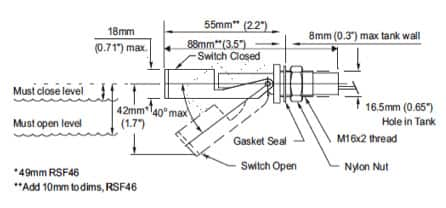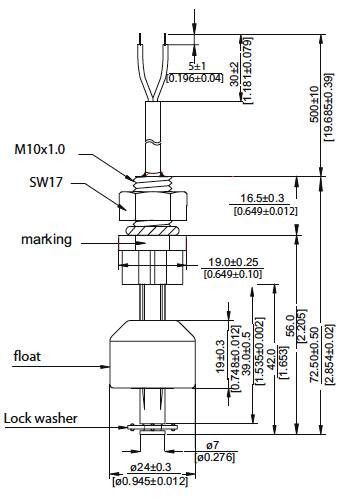Material Selection for Liquid-Level Sensors
投稿人:电子产品
2013-01-17
Liquid-level sensors come in a wide variety of different types, including bubbler, capacitance, resistance, float, optical, radar and microwave, ultrasonic, and vibrating or tuning fork. Not only do the types vary, but so do the materials from which they are made. The choice of material should be based on both the fluid being measured and the environment where the liquid resides. Temperature, pressure, and need for a sterile environment also come into play.
The materials used in the creation of the sensors specifically address the application at hand and the type of devices used within. Whether they manage flow rates into and out of storage containers, or are used when liquid fills or is stored in a tank, liquid-level monitoring is an important and often critical aspect of the complete process. These sensors are used with water-based, organic, or highly corrosive materials, and their primary function is to alert to low levels or overflow conditions.
Liquid-level sensors are continuous-level sensors that measure levels within a specific area, determining and measuring the exact amount of liquid, slurry, or granular materials and powders in a specific location. Point-level sensors, in comparison, indicate whether the substance measured is above or below a certain sensing point. Typical materials used in sensor construction are polypropylene, stainless steel, brass, Buna-N, nylon, Kynar, and polyphenylene sulfide. This article will present an overview as to where and how each of the materials is used.
Nylon
Nylon is typically used in detecting oils and petroleum. Although it is also used for water and food, more often polypropylene is the preferred choice. An example of this type of sensor is the LLF Series by Cynergy3. Used in applications where very low liquid levels need to be detected and where highly sensitive liquid detection is necessary, the LLF uses a large diameter Buna float (Figure 1) to allow operation in SG as low as 0.45. The switch can operate in as little as 6 mm of water.
Applications include drip tanks, hatch alarms, and other applications where highly sensitive liquid detection is required.

Figure 1: The LLF Series of liquid-level sensors is used where sensitive detection is required.
Polypropylene
Polypropylene is most often used for hot-water applications and with acidic liquids such as those used in metal cleaning. It is also used for lower-temperature food operations (up to 105°C). The material is a good fit for commercial appliances and equipment, as well as several general-purpose applications. An example is the Standex-Meder LS03 Series electronic level sensors with magnetic floats. The sensor comes in PP (Polypropylene) for water applications and dilute acids and PA (Polyamide) for use in oil, gasoline (petrol), and brake fluid.
Polyphenylene Sulfide
Polyphenylene sulfide (PPS) is used with aggressive acids and many industrial-grade liquids as it features excellent chemical resistance.
Very often, we find liquid-level sensors offered in several material options as with the RSF40 Series from Cynergy3 (Figure 2). Offered in nylon, polypropylene, or PPS, and offering a choice of gasket materials to suit most commonly used liquids, the series is a compact internal fitting device that is ideal for size-sensitive applications such as vending machines, commercial washing machines, and evaporator units. This series is mounted on the inside of a tank.

Figure 2: Mechanical dimensions of the RSF40 Series by Cynergy3, available in nylon, polypropylene, or PPS.
Stainless steel
Stainless steel is used with aggressive or corrosive liquids including acids, chemical-based liquids, salt water and coolant, and offers an explosion-proof alternative to plastics. It is suited to industrial, military, heating, motorsports, and automotive applications. Stainless steel is generally used in sensors for high-temperature and high-pressure environments and corrosive conditions.
The Standex-Meder LS02 Series (Figure 3) features a stainless-steel housing, two versions based on applications such as water and dilute acid apps, and an option for use in oil, gasoline, and brake fluid. The applications for this device include liquid container monitoring in household appliances, automotive applications, test and measurement, and control technology.

Figure 3: The Standex-Meder LS02 Series combines a stainless-steel housing with either polypropylene or polyamide versions based on application.
While these sensor materials represent the majority of applications, others are also used. Kynar polyvinylidene fluoride (PVDF), for example, is used when there is a need for chemical and solvent-resistant properties. The material has high purity, so it is often used for medical, food handling, and sensitive test equipment. Buna-N (Nitrile rubber) is used for aromatic hydrocarbons, and dilute acids and bases as with fuel tanks, hydraulic fluid storage, and transmissions. Brass is often used in petroleum-based liquids such as gasoline, lubricant oils, in-vehicle, generator, or hydraulic applications.
At times, level measurements must be external and performed at a distance from the material. This is true with molten materials or glasses, and within environments where the liquids may be not only corrosive, but emit toxic fumes. In these cases, optical sensing is used. Rather than being in direct contact with the liquid, these sensors rely on the light transmitting, reflecting, and refracting properties of materials being processed.
Summary
Any commercial or industrial process involving the filling or storing of a liquid in a tank or vessel will benefit from the use of a liquid-level sensor. Liquid-level sensors in particular are used in applications where the liquid level to be measured is important (if for no other reason than the costly nature of the liquids involved). As an example, consider alcoholic beverages, where each inch of liquid level resident in the huge vat may represent tens of thousands of dollars, so the sensor material used is critical.
By using a Chemical Compatibility Chart, users have a good indication of the suitability of sensor materials relative to a wide range of liquids. It may still be necessary in some cases, however, to obtain a sample sensor to test compatibility.
In this article we have discussed the options an engineer has in choosing materials for a fluid level sensor and presented a sampling of available product. For more information on the products mentioned in this article, use the links provided to access product information pages on the DigiKey website.
免责声明:各个作者和/或论坛参与者在本网站发表的观点、看法和意见不代表 DigiKey 的观点、看法和意见,也不代表 DigiKey 官方政策。









